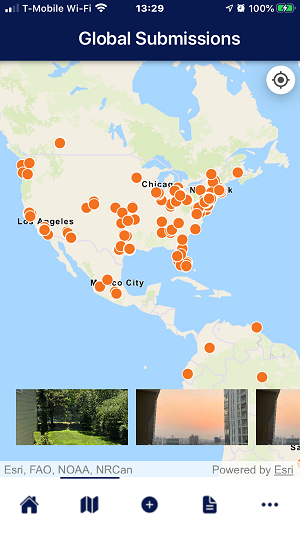
Marking National Insect Week, Earth Challenge 2020, a global citizen science partnership between the Earth Day Network, the Wilson Center, and the US State Department, announced two new applications supported by Kinetica, intended to address food security and insect populations.
“One part of building capacity for citizen science is supporting research through new technology, while the second part is facilitating action,” said Dr. Anne Bowser, Director of Innovation at the Wilson Center. “Our intention is that the Wilson Center, State Department, and Earth Day Network’s Earth Challenge 2020 tools will ultimately be used by the global research and policy communities to understand and help solve challenges in any research domain.”
To begin to explore research areas like the threat of monocultures to global food production, Earth Challenge 2020’s citizen scientists will use the International Institute for Applied Systems Analysis’ (IIASA) Picture Pile app to label pictures of different crops. These labeled images will add value to global data sets collected by the European Space Agency by providing a new reference data set that can cross-validate Earth observations. Kinetica makes sure that data from the app is flowing, and stitches together different source data sets to support the documentation. Once citizen scientists have labeled enough images, machine learning algorithms can be taught to label the remaining agricultural land documented globally. These efforts will allow scientists to identify monocultures that threaten soil nutrients, native plants, and the longer-term diversity and sustainability of the global food supply chain.
“Ensuring food supply from land increasingly under pressure is a key challenge of this century, but a lack of accurate information on the spatial distribution of major crop types hampers policy and strategic investment. Our partnership with Earth Challenge 2020 will allow us to create a new innovative crop type reference and training database, which is essential to produce accurate depictions of global food supply for agencies around the world,” commented Steffen Fritz, Earth Observation and Citizen Science Center Head and Ecosystems Services and Management Deputy Program Director at IIASA.
National crop coverage data in the United States is updated each decade, but hand in hand with citizen science, researchers will now be able to work with current, open, standardized, and reliable data, opening up new opportunities for study. Earth Challenge 2020 is able to take broad satellite data, add citizen science-sourced data, and create a data set that is both broad and granular, and therefore more useful to the scientific community.
“To date, citizen science is a largely untapped resource because it has been collected inconsistently by individuals, missing necessary documentation and data,” said Paul Appleby, CEO, Kinetica. “Earth Challenge 2020 breaks new ground by offering a platform that taps into the power of people to collect scientific data using the super computers we all keep in our pockets, contributing directly to meaningful scientific progress on a truly global scale.”

Earth Challenge 2020 is also releasing an application to identify insect populations, particularly three types of bee: honey bees, carpenter bees, and bumblebees. The app will ultimately be able to help identify where native insects, like bumble bees, are located to help inform conservation policies. The app teaches users to photograph and correctly identify insects, and then upload and tag those photos by type and location. Kinetica artificial intelligence models learn what differentiates a carpenter bee from a honey bee, for example, and from there, can trawl the citizen-submitted photos to verify accurate labeling. The app running on Kinetica is then able to aggregate and display the data about what types of bees are where. With this information, we will see which areas lack native bees, and in turn, face a loss of native plants and crops that require native bees for pollination. With more data than ever before, the community of concerned citizens and scientists can work together on conservation efforts.
Earth Challenge 2020 benefits participating citizens as well as the scientific community, building global science literacy at a critical time for our planet’s population. “These new apps will create a global open source citizen science database and opportunities for civic engagement,” said Kathleen Rogers, President of Earth Day Network. “People everywhere can help build the most up-to-date scientific assessments needed globally, and at the same time take action locally.”
Earth Challenge 2020 is part of the Earth School coalition spearheaded by the United Nations Environment Programme and TED-Ed, which came together to provide free, high-quality educational science content to students, parents, and teachers around the world, while more than 1.5 billion learners are currently at home in response to the COVID-19 pandemic.
Earth Challenge 2020 collects and integrates billions of data points into the Kinetica Active Analytics Platform, powered by NVIDIA GPUs, across research areas impacting the environment and human health, with two more initiatives, focused on water quality and climate change, scheduled to roll out later in the year. Citizens can participate through the Earth Challenge mobile app. Datasets will be available in the Citizen Science Cloud and publicly accessible through Kinetica REST APIs, enabling people around the world to act on data collected to build safer, healthier communities.
Download the mobile app for Apple or Android to get involved directly in Earth Challenge 2020 scientific research initiatives and to access and share scientific data with your community.
Sign up for the free insideAI News newsletter.




Speak Your Mind